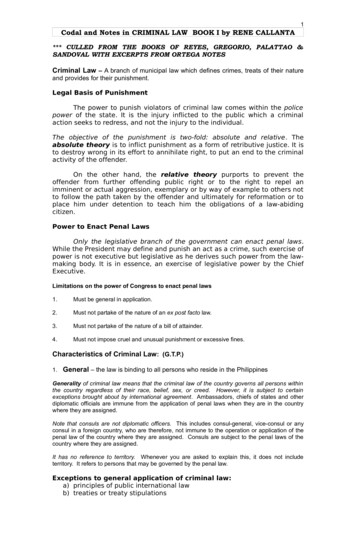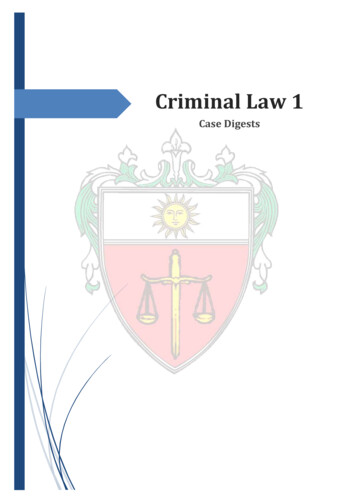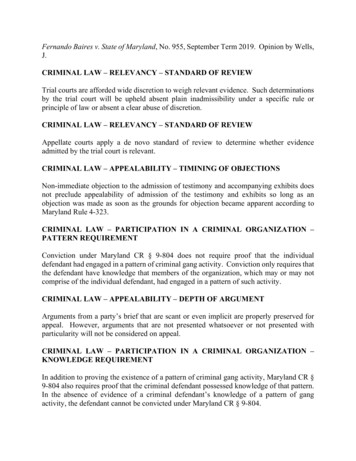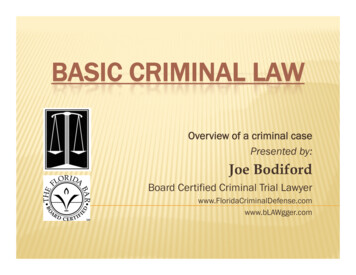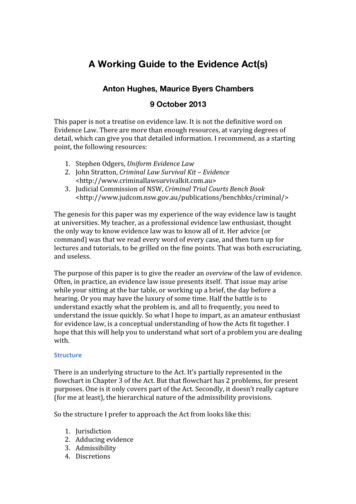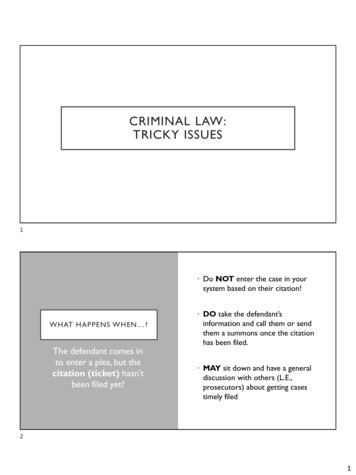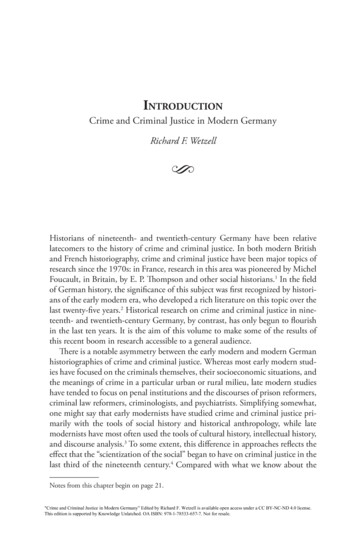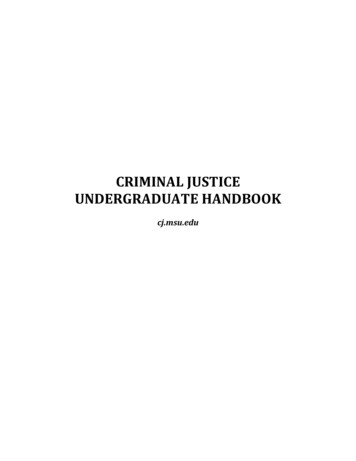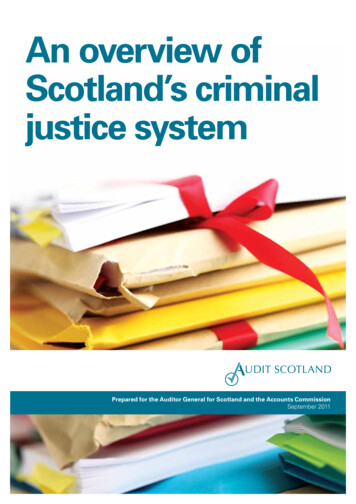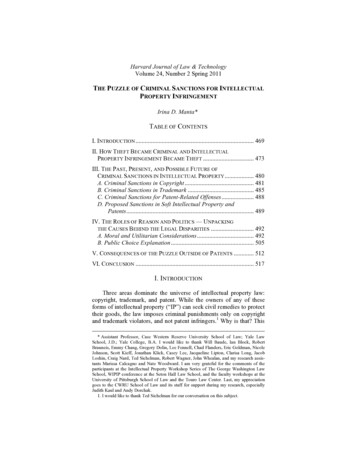
Transcription
Harvard Journal of Law & TechnologyVolume 24, Number 2 Spring 2011THE PUZZLE OF CRIMINAL SANCTIONS FOR INTELLECTUALPROPERTY INFRINGEMENTIrina D. Manta*TABLE OF CONTENTSI. INTRODUCTION . 469II. HOW THEFT BECAME CRIMINAL AND INTELLECTUALPROPERTY INFRINGEMENT B ECAME THEFT . 473III. THE PAST, PRESENT, AND POSSIBLE FUTURE OFCRIMINAL SANCTIONS IN INTELLECTUAL PROPERTY . 480A. Criminal Sanctions in Copyright . 481B. Criminal Sanctions in Trademark . 485C. Criminal Sanctions for Patent-Related Offenses. 488D. Proposed Sanctions in Soft Intellectual Property andPatents. 489IV. THE R OLES OF REASON AND POLITICS — UNPACKINGTHE CAUSES B EHIND THE LEGAL DISPARITIES . 492A. Moral and Utilitarian Considerations. 492B. Public Choice Explanation . 505V. CONSEQUENCES OF THE PUZZLE OUTSIDE OF PATENTS . 512VI. CONCLUSION . 517I. INTRODUCTIONThree areas dominate the universe of intellectual property law:copyright, trademark, and patent. While the owners of any of theseforms of intellectual property (“IP”) can seek civil remedies to protecttheir goods, the law imposes criminal punishments only on copyrightand trademark violators, and not patent infringers.1 Why is that? This* Assistant Professor, Case Western Reserve University School of Law; Yale LawSchool, J.D.; Yale College, B.A. I would like to thank Will Baude, Ian Block, RobertBrauneis, Emmy Chang, Gregory Dolin, Lee Fennell, Chad Flanders, Eric Goldman, NicoleJohnson, Scott Kieff, Jonathan Klick, Casey Lee, Jacqueline Lipton, Clarisa Long, JacobLoshin, Craig Nard, Ted Sichelman, Robert Wagner, John Whealan, and my research assistants Marissa Calcagno and Nate Woodward. I am very grateful for the comments of theparticipants at the Intellectual Property Workshop Series of The George Washington LawSchool, WIPIP conference at the Seton Hall Law School, and the faculty workshops at theUniversity of Pittsburgh School of Law and the Touro Law Center. Last, my appreciationgoes to the CWRU School of Law and its staff for support during my research, especiallyJudith Kaul and Andy Dorchak.1. I would like to thank Ted Sichelman for our conversation on this subject.
470Harvard Journal of Law & Technology[Vol. 24Article argues that the disparity has arisen from both moral and utilitarian rationales and the political landscape of the patent industry. Asthis landscape shifts and the United States negotiates a wide variety ofinternational agreements in the IP arena, however, political forcesthreaten to overpower the discourse on criminal sanctions in IP. ThisArticle proposes an analytical and normative framework to understandthe nature of these sanctions and provides guidance regarding the optimal role of such sanctions in IP law.The disparity in the availability of criminal sanctions for differentforms of IP subject matter is counterintuitive, as the following hypothetical demonstrates. Let us imagine that The Great New MediaCompany (“GNMC”) creates a novel type of disc on which data suchas movies can be recorded. The disc is more durable than existingones because its top layer consists of a newly invented material, andGNMC obtains a patent for this disc technology. An entertainmentcompany named Awesome Movie Makers (“AMM”) decides to distribute one of its recent hit movies on the GNMC discs, and the twocompanies reach an agreement for this distribution. The disc withAMM’s movie is sold at major outlets and becomes a commercialsuccess. John Doe, who runs an illicit bootlegging business, managesto produce discs that contain GNMC’s patented disc technology withthe help of some other associates. He then copies AMM’s hit movieonto a set of the discs and decides to sell them on the street. To feignlegitimacy, he affixes a label on each disc that uses AMM’s trademarked logo and reads “Endorsed by Awesome Movie Makers.”Doe’s scheme is uncovered and the local federal prosecutor decides to pursue him criminally for his willful actions. He facescharges for criminal copyright infringement for copying and sellingAMM’s movie illegally. He is similarly confronted with criminalsanctions for his use of AMM’s trademarked logo. The prosecutor,however, cannot charge Doe with any crimes related to his infringement of GNMC’s patent. GNMC can try to recover losses through acivil patent infringement lawsuit, just as AMM can initiate civil suitsfor copyright and trademark infringement, but Doe’s actions againstGNMC will remain unpunished by the criminal law. This appears particularly puzzling given that his motivation — to make a profit fromthe willful copying of protected material — is the same with respectto all three types of infringement, and given that similar actions ranafoul of the three IP regimes.One could argue that we have departed from the sentiment expressed in the British judge Sir James Eyre’s 1774 statement that “[a]mechanical Invention and a literary Composition exactly agree inPoint of Similarity; the one therefore is no more entitled to be the Ob-
No. 2]Criminal Sanctions for IP Infringement471ject of Common Law Property than the other.”2 Is the United Statestreating “soft” IP (i.e., copyrights and trademarks) more like propertythan it does patents by criminalizing “theft” of the former but not thelatter? In any case, some commentators have claimed that large companies and individuals are on a “tilted playing field”3 with respect totheir respective IP rights: “If you violate the rights of a big corporation by transferring a song or movie they own without payment, theycan have you hauled away. If they steal your invention, all the onusfor prosecution is on you and the worst that can happen is they write acheck.”4 One may conclude that the criminal law ought to correct thisimbalance.The question of introducing criminal sanctions for patent infringement is far from purely theoretical: the European Union seriously debated for several years the introduction of such sanctions andonly dropped the idea under great pressure from information technology (“IT”) companies and grassroots organizations.5 If the EU doeseventually choose to adopt criminal penalties, this would deepen alongstanding divide between the United States and several other countries; one article noted in 1935 that “[i]n many foreign countries, thewillful infringement of a patent is punishable by fine or imprisonmentor both,”6 and its author went on to name twenty-three countrieswhere this was the case.7 Numerous countries still have criminal provisions for patent law infringement, with varying levels of enforcement.8 Currently, the United States and other countries have releasedthe finalized text of the Anti-Counterfeiting Trade Agreement(“ACTA”), which would strengthen the enforcement of both civil andcriminal sanctions for IP infringement to help stem counterfeiting and2. Nigel Stirk, Intellectual Property and the Role of Manufacturers: Definitions from theLate Eighteenth Century, 27 J. HIST. G EOGRAPHY 475, 478 (2001).3. Dana Blankenhorn, Time To Criminalize Patent Violations?, SMARTPLANET (Sept. s/1268/.4. Id.5. See, e.g., Paul Meller, Odd Coalition Opposes Criminalizing Patent Violations, N.Y.TIMES, Dec. 10, 2005, at C4, available at siness/10patent.html? r 1.6. John Boyle, Jr., May Patent Infringement Be a Criminal Conspiracy?, 17 J. PAT. OFF.SOC’ Y 529, 529 (1935).7. Id. (“Among these countries are France, Germany, Italy, Austria, Denmark, Norway,Sweden, Spain, Bulgaria, Greece, Luxemburg, Persia, Poland, Argentine Republic, Bolivia,Brazil, Chile, Ecuador, Guatemala, Honduras, Paraguay, Peru and Uruguay.”).8. See, e.g., Eric Le Forestier, I NTERNATIONAL FEDERATION OF I NTELLECTUALPROPERTY A TTORNEYS, REPORT ON WORKSHOP 2 — RKRIMINAL SANCTIONS OF IPINFRINGEMENT” (2007) (explaining criminal sanctions in Austria, Italy, Brazil, and othercountries); Siriporn Denkesineelam, Intellectual Property in Thailand, HG.ORG (June 30,2010), http://www.hg.org/article.asp?id 19222 (discussing criminal punishments for patentinfringement in Thailand); Kazuo Iwasaki, Intellectual Property Protection in Japan,IWASAKI KAZUO, http://homepage3.nifty.com/Prof K Iwasaki/lawdb/japan/invstmnt/intppen.html#PAT4 (last visited May 6, 2011) (mentioning the availability of such sanctions inJapan).
472Harvard Journal of Law & Technology[Vol. 24piracy in international trade;9 the main focus of ACTA, however, issoft IP rather than patent infringement.10 Even so, the discussions surrounding ACTA have sparked interest in a variety of matters concerning criminal enforcement of IP infringement.11Multiple theories could explain why the United States has criminalized copyright and trademark infringement but not patent infringement. There could be a moral or utilitarian distinction betweensoft IP and patents, and the differing availability of criminal sanctionsmay be warranted because infringers of soft IP cause more harmand/or require harsher punishments for deterrence than infringers ofpatents.12 Alternatively, perhaps criminalizing soft IP infringementprovides the proper balance of incentives for creators by giving themthe safety of added protections for their works, whereas it wouldoverly deter inventors in the patent context. Another possible explanation for the distinction is a public choice rationale: while a number ofindustries lobby for stronger protection for soft IP (especially copyright), different industries are at odds with one another regarding theproper level of protection for patents.13 As this Article will demonstrate, all of these elements play a role in shaping criminal IP laws.Part II explores the justifications for criminal sanctions in theproperty arena and their potential application to IP violations. Part IIIdiscusses the existence or non-existence of criminal sanctions for different forms of IP infringement and shows how recent internationaldevelopments may influence the future course of the law in the UnitedStates. Part IV examines in more detail some of the explanatory theories for the disparity, including those based on morality, utilitarianism,and public choice. Part V draws normative conclusions for IP outsideof patent law based on the insights developed in Part IV, focusingespecially on the issue of non-commercial violations of copyright law.Part VI concludes.9. See Anti-Counterfeiting Trade Agreement (ACTA), OFF. OF THE U.S. TRADEREPRESENTATIVE, http://www.ustr.gov/acta (last visited May 6, 2011).10. See Anti-Counterfeiting Trade Agreement, Dec. 3, 2010 [hereinafter ACTA December Draft], available at http://www.ustr.gov/webfm send/2417.11. For instance, a number of authors are working on a collaborative book project thatexamines the international dimensions of criminal enforcement, mainly discussing the fightagainst trademark counterfeiting and copyright infringement and presenting the nationalexperiences of several countries with these soft IP issues. See CRIMINAL ENFORCEMENT OFINTELLECTUAL PROPERTY: A BLESSING OR A CURSE? (Christophe Geiger ed., forthcoming2011).12. This is, of course, a contested point, as this Article will discuss. See infra Parts IV–V.13. I would like to thank Craig Nard for our discussion about this theory.
No. 2]Criminal Sanctions for IP Infringement473II. HOW THEFT BECAME CRIMINAL AND INTELLECTUALPROPERTY INFRINGEMENT BECAME THEFTMany trace the criminalization of IP back to much earlier developments in property law. This Part analyzes the justification of criminal sanctions for infringements on property law, such as theft, andexplains the rationales for applying some of these principles to IP law.This is not an attempt to resolve the perpetual questions of whether IPqualifies as property, or whether the answer to that question dependson the type of IP involved.14 Rather, this Article recognizes that as amatter of historical record, policymakers have largely relied uponanalogies to property law in their decisions to introduce and legitimizecriminal sanctions for violations of IP laws. It is thus both necessaryand useful to begin with an understanding of how governments andscholars have justified criminalizing violations of property law, andhow this reasoning was later — for better or for worse — extended tothe IP arena.Much of the legislative and scholarly rhetoric in the United Statesand abroad characterizes some forms of IP infringement as “theft,”15 aterm that one traditionally encounters when dealing with illegitimatetakings of tangible property. Black’s Law Dictionary defines theft asthe “felonious taking and removing of another’s personal propertywith the intent of depriving the true owner of it.”16 The traditional“bundle of rights” in property mainly contains “the rights to possessthe property, to use the property, to exclude others from the property,14. The list of scholarly articles on this topic is long. See, e.g., Stephen L. Carter, Does ItMatter Whether Intellectual Property Is Property?, 68 CHI.-KENT L. REV. 715 (1993);Frank H. Easterbrook, Intellectual Property Is Still Property, 13 HARV. J.L. & PUB. POL’ Y108 (1990); Richard A. Epstein, Liberty Versus Property? Cracks in the Foundations ofCopyright Law, 42 SAN DIEGO L. REV. 1 (2005); F. Scott Kieff, Property Rights and Property Rules for Commercializing Inventions, 85 MINN. L. REV. 697 (2001); Mark A. Lemley,Property, Intellectual Property, and Free Riding, 83 TEX. L. REV. 1031 (2005); AdamMossoff
09.03.2010 · B. Criminal Sanctions in Trademark . Emmy Chang, Gregory Dolin, Lee Fennell, Chad Flanders, Eric Goldman, Nicole Johnson, Scott Kieff, Jonathan Klick, Casey Lee, Jacqueline Lipton, Clarisa Long, Jacob Loshin, Craig Nard, Ted Sichelman, Robert Wagner, John Whealan, and my research assis- tants Marissa Calcagno and Nate Woodward. I am very grateful for the comments of
